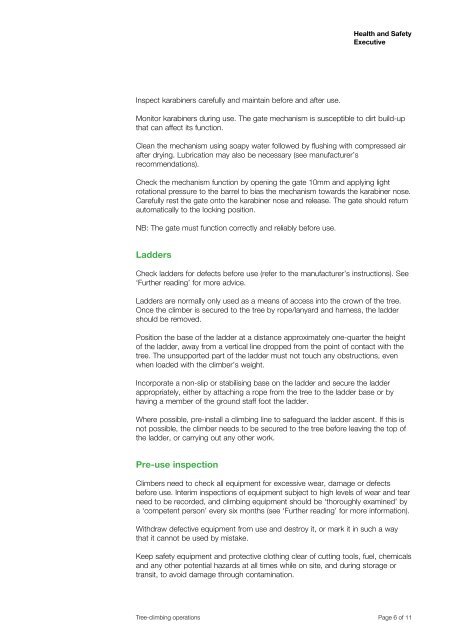Tree-climbing operations AFAG401 - HSE
Tree-climbing operations AFAG401 - HSE
Tree-climbing operations AFAG401 - HSE
Create successful ePaper yourself
Turn your PDF publications into a flip-book with our unique Google optimized e-Paper software.
Health and Safety<br />
Executive<br />
Inspect karabiners carefully and maintain before and after use.<br />
Monitor karabiners during use. The gate mechanism is susceptible to dirt build-up<br />
that can affect its function.<br />
Clean the mechanism using soapy water followed by flushing with compressed air<br />
after drying. Lubrication may also be necessary (see manufacturer’s<br />
recommendations).<br />
Check the mechanism function by opening the gate 10mm and applying light<br />
rotational pressure to the barrel to bias the mechanism towards the karabiner nose.<br />
Carefully rest the gate onto the karabiner nose and release. The gate should return<br />
automatically to the locking position.<br />
NB: The gate must function correctly and reliably before use.<br />
Ladders<br />
Check ladders for defects before use (refer to the manufacturer’s instructions). See<br />
‘Further reading’ for more advice.<br />
Ladders are normally only used as a means of access into the crown of the tree.<br />
Once the climber is secured to the tree by rope/lanyard and harness, the ladder<br />
should be removed.<br />
Position the base of the ladder at a distance approximately one-quarter the height<br />
of the ladder, away from a vertical line dropped from the point of contact with the<br />
tree. The unsupported part of the ladder must not touch any obstructions, even<br />
when loaded with the climber’s weight.<br />
Incorporate a non-slip or stabilising base on the ladder and secure the ladder<br />
appropriately, either by attaching a rope from the tree to the ladder base or by<br />
having a member of the ground staff foot the ladder.<br />
Where possible, pre-install a <strong>climbing</strong> line to safeguard the ladder ascent. If this is<br />
not possible, the climber needs to be secured to the tree before leaving the top of<br />
the ladder, or carrying out any other work.<br />
Pre-use inspection<br />
Climbers need to check all equipment for excessive wear, damage or defects<br />
before use. Interim inspections of equipment subject to high levels of wear and tear<br />
need to be recorded, and <strong>climbing</strong> equipment should be ‘thoroughly examined’ by<br />
a ‘competent person’ every six months (see ‘Further reading’ for more information).<br />
Withdraw defective equipment from use and destroy it, or mark it in such a way<br />
that it cannot be used by mistake.<br />
Keep safety equipment and protective clothing clear of cutting tools, fuel, chemicals<br />
and any other potential hazards at all times while on site, and during storage or<br />
transit, to avoid damage through contamination.<br />
<strong>Tree</strong>-<strong>climbing</strong> <strong>operations</strong> Page 6 of 11

















